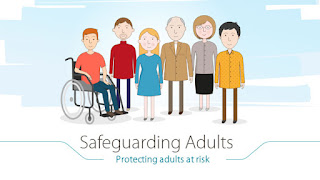By Jennifer Robinson, Safeguarding Consultant
What is the difference between adult
and child safeguarding?
One of the first questions I am often
asked is ‘what’s the difference?', or 'why is there a difference? Surely its all
the same?’ My answer is that issues to consider when working with safeguarding
adults is the difference between children and adults. Much is published about safeguarding
children, and we have many stories in the public eye to remind us of the
sadness and complexity of this issue.
However, safeguarding adults does not attract as much attention, and we
have to rely on cases such as Stephen Hoskins from 2006 and care homes such as Whorlton Hall in May of this year to remind us of the
terrible abuse that some adults endure.
So, to answer the question, the
difference between adult safeguarding and child safeguarding is very basic, and
is dependent on age. Children, by their
very definition, are unable to make decisions for themselves and therefore
will always be reliant on adults to make decisions and choices for them. Adults
however, if they have the mental capacity to do so, can make decisions, albeit
what we may feel are unwise, the decision is entirely their own. We require their consent.
So, what does adult safeguarding mean?
There are many definitions for adult
safeguarding depending on the organisation, however, the best summary I have
seen is as below: -
‘Protecting an adult’s right to
live in safety, free from abuse and neglect. It is about people and
organisations working together to prevent and stop both the risks and
experience of abuse or neglect, while at the same time making sure that the
adult’s wellbeing is promoted including, where appropriate, having regard to
their views, wishes, feelings and beliefs in deciding on any action. This must
recognise that adults sometimes have complex interpersonal relationships and
may be ambivalent, unclear or unrealistic about their personal circumstances.’
Social Care
Institute for Excellence 2019
This definition
of adult safeguarding hints at the complexity of safeguarding adults, and the
definition of the threshold for a safeguarding response is well defined in the
Care Act 2014 as below:
- has needs for care and support (whether or not the authority is meeting any of those needs),
- is experiencing, or is at risk of, abuse or neglect and
- as a result of those needs is unable to protect himself or herself against the abuse or neglect or the risk of it.’
The history of
adult safeguarding.
The best place
to begin is in the year 2000, when the government issued a guidance paper (Code
of Practice) on how to work with adults who are at risk of, or experiencing
abuse. This was called ‘No Secrets’ in
England, and ‘In Safe Hands’ in Wales. This was not enshrined in law, but local
authorities had to be prepared to undertake inspections to ensure compliance,
if necessary.
This guidance
recommended that in each local authority, a selection of social workers was
specifically trained in undertaking investigations when allegations were brought to the attention of the local authority.
Although this
guidance mentions agencies working together, and consultation with the
vulnerable adult at risk, it is not as robust as the current legislation. 'No Secrets' focused on protection/safety of
vulnerable adults and often resulted in knee-jerk reactions to incident of
abuse. Some 14 years after its inception, it was superseded by the robust
legislation of the Care Act 2014. One of
the main reasons for this legislation was the aforementioned case
of Stephen Hoskins, who in 2006 was tortured and murdered at the hands of 3
adults, one of whom was also vulnerable and known to police services.
As in all cases
of death or serious injury, a Serious Case Review was instigated and pinpointed
a lack of professional awareness of adult safeguarding, a need for clear
thresholds (as in children’s safeguarding), the importance of robust
interventions of vulnerable adults and the importance of information sharing
amongst professionals.
After this lack
of serious legislative underpinning with No Secrets was
recognised by the Government, the response was the Care Act 2014. The Care Act focuses on what is termed as
Making Safeguarding Personal. This is a
person-centred approached that allows vulnerable adults to stay at the centre
of decisions made about them, and for personalisation packages for their care
to be written up between them and any organisations assisting with their
care. Other safeguards, such as the
Mental Capacity Act and the Vulnerable Person’s Act are also used to ensure its
safe delivery.
Adult
safeguarding is as any safeguarding procedure, only as good as the people
delivering it; however, it must be agreed that with the underpinning of robust
legislations (as with child safeguarding), the outcome for this vulnerable group
is far better than previously.
There are many
different sources of data regarding the amount of reported cases of abuse,
making a collective figure hard to find. However, I have viewed the NHS report,
feeling that this is most likely the largest area covered in the UK. The NHS report shows that during 2017 – 2018, 394,665 cases of concern were raised, resulting in a total of 150,070
safeguarding enquiries. Whilst this
figure may appear alarming, this indicates that cases of abuse are being
robustly dealt with, creating a safer and secure environment for vulnerable
adults.
For more
information on all things adult safeguarding a useful website is SCIE.org.uk.





Comments
Post a Comment